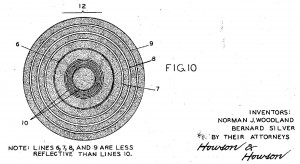The Little-Known History Of The First ‘Bullseye’ Barcode
Whilst we take the humble barcode for granted today, the symbol is the result of decades of investment and innovation. It was 80 years ago in 1947 that Bernard Silver overheard a local grocery store owner talking about the need for technology to speed up purchasing and simplify stock-keeping. Silver mentioned the conversation to his inventor friend, Norman Joseph Woodland, and the two began problem solving.
The eureka moment…
Woodland was sitting on a beach in Florida when he got his first inspiration – from Morse Code. “…I was thinking about dots and dashes when I poked my four fingers into the sand and, for whatever reason…I pulled my hand toward me and I had four lines…..Now I have four lines and they could be wide lines and narrow lines, instead of dots and dashes…Then, only seconds later, I took my four fingers…and I swept them round into a circle.”
In 1949 Woodland and Silver applied for a patent of a ‘bullseye’ barcode system they called a ‘Classifying Apparatus and Method’ [granted in 1952]. It worked up to a point, but there were issues with the invention’s size and the impractical way retailers would have to read codes with a large bright light – that is, until the miniaturised laser light beam was invented years later.

In the 1950’s, Woodland began working for IBM and lobbied them to acquire the patent. IBM concluded at that time that whilst the idea was interesting, processing the resulting data would require equipment not yet in existence, so there was no deal. Woodland and Silver ended up selling their patent to Philco who later sold it to RCA.
The race for a workable UPC…
The patent sat idle until 1966 when the US National Association of Food Chains [NAFC], in conjunction with consulting firm McKinsey & Co, asked for submissions for a Universal Product Code [UPC] – a standard that would be common to all goods sold in supermarkets. The code could carry product, manufacturer and pricing information.
A multi-year submission process included ideas from technology companies Pitney Bowes, Litton Industries, Plessey-Anker, Scanner Inc., Singer, Dymo Industries, IBM – and RCA who probably thought they were the only real contenders given it still held the original patent.
In July 1972, RCA even conducted an expensive 18-month test of their bullseye system in a Kroger store in Cincinnati. Barcodes were printed on small pieces of adhesive paper, and attached by hand by store employees when they were adding price tags. However the code proved to have a serious problem – whilst the circular shape could be read from any angle, the printers would smudge the ink, rendering the code unreadable regardless of orientation.
IBM’s Laurer and Woodland…
Meanwhile, over at IBM, engineer George Laurer, with the help of Woodland, went to work on developing a user-friendly digitally-readable code that could be more easily scanned. They initially tried to resurrect Woodland’s bullseye format, but due to its issues decided it wasn’t feasible for the mass market. After a number of iterations, the black and white rectangle with a series of short paralleled lines was born. The smudge-read problem was overcome, since the code could be printed in the direction of the stripes, so any bleeding of the ink would simply make the code taller.
At the same time, another group of IBM engineers developed a prototype barcode scanner using optics and lasers. So on 3 April 1973, IBM’s UPC system was finally selected as the NAFC standard. A testbed of the IBM system was installed by NCR Corporation at Marsh’s Supermarket in Troy, Ohio, near the factory that was producing the equipment. On June 26, 1974, the first swipe was done on a pack of Wrigley’s Juicy Fruit gum. Although the trolley was full of goods, the selection of the packet of gum by this first customer, Clyde Dawson from the R&D department of Marsh Supermarkets, was not a coincidence. Despite having many other items in his basket, he selected the gum first to demonstrate that it was possible to successfully print and read a barcode on even the smallest of grocery items. This packet is now on display at the Smithsonian in Washington, D.C.
Still proving its value…
Within a short time the system proved its worth. Checkout costs reduced and speed increased by around 40%. Inventory management productivity and accuracy dramatically improved also. A byproduct was the ability of stores to track the buying habits of customers and the scanning of coupons and loyalty cards to drive sales. Between 1976 and 1980, the number of stores using this technology grew from 104 to 2,207, and the system spread to countries outside the US.
Today the barcode has evolved from the linear 1D format to 2D codes that include dots, hexagons and other geometric patterns that can be read by our mobile phones. Not only do they track the products we buy, they encode patient information in hospitals to eliminate errors, enable logistics companies to track and trace packages in near real-time, allow travelers to check into flights using their smartphones and so much more.
The question now often touted is whether barcodes will ever be fully-replaced by newer, non-line-of-sight auto-ID technology such as RFID? Whilst we don’t yet know the answer to this, Relegen has developed its assetDNA technology platform to be tag-independent, and future-proof, no matter what asset identification and authentication inventions and innovations are to come. Our item-level serialisation software works with any kind of asset tagging [Barcode, HF & UHF RFID, NFC, DPM, Covert Security Tagging & more] and codification standard and can be easily deployed across a wide variety of business applications. To learn more, or request a free software demonstration, contact us on sales@relegen.com or + 61 (0)2 9998 9000.